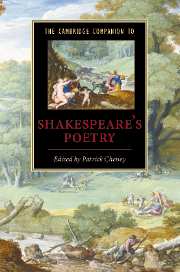Book contents
- Frontmatter
- Introduction: Shakespeare’s poetry in the twenty-first century
- 1 Shakespeare and the development of English poetry
- 2 Rhetoric, style, and poetic form
- 3 Print and manuscript
- 4 Venus and Adonis
- 5 The Rape of Lucrece
- 6 The Passionate Pilgrim and ‘The Phoenix and Turtle’
- 7 The Sonnets
- 8 A Lover’s Complaint
- 9 Poetry, politics, and religion
- 10 Love, beauty, and sexuality
- 11 Shakespeare and classicism
- 12 Poetry in Shakespeare’s plays
- 13 Poetry and performance
- 14 Reception and influence
- Reference works on Shakespeare’s poetry
- Index
6 - The Passionate Pilgrim and ‘The Phoenix and Turtle’
Published online by Cambridge University Press: 28 May 2007
- Frontmatter
- Introduction: Shakespeare’s poetry in the twenty-first century
- 1 Shakespeare and the development of English poetry
- 2 Rhetoric, style, and poetic form
- 3 Print and manuscript
- 4 Venus and Adonis
- 5 The Rape of Lucrece
- 6 The Passionate Pilgrim and ‘The Phoenix and Turtle’
- 7 The Sonnets
- 8 A Lover’s Complaint
- 9 Poetry, politics, and religion
- 10 Love, beauty, and sexuality
- 11 Shakespeare and classicism
- 12 Poetry in Shakespeare’s plays
- 13 Poetry and performance
- 14 Reception and influence
- Reference works on Shakespeare’s poetry
- Index
Summary
In the long interim between the publication of Lucrece (1594) and The Sonnets (1609), Shakespeare's poetry was featured in two verse miscellanies, The Passionate Pilgrim (printed twice between September 1598 and 1599, then expanded in 1612) and Love's Martyr (published in 1601 and reissued as The Annals of Great Britain in 1611), that testify, albeit in different ways, to his dual literary reputation as a lyric poet and commercial dramatist. For while The Passionate Pilgrim is most valuable as an historical document registering Shakespeare's contemporary popularity, Love's Martyr, which includes his mysterious unnamed elegy sometimes known as 'The Phoenix and Turtle', not only affords a glimpse of the conditions that shaped his emergent reputation, but also indicates how his ongoing involvement with the hybrid theatrical/literary culture of late Elizabethan England contributed to the creation of this enigmatic lyric masterpiece.
The Passionate Pilgrim
Attributed on its title page to 'W. Shakespeare', The Passionate Pilgrim, published by William Jaggard, who would later print the First Folio, is a short octavo edition that might be called the first anthology of Shakespeare's verse with one major qualification: most of the poems are not his. In 1598 Francis Meres in Palladis Tamia tantalized readers with a reference to Shakespeare's 'sugared Sonnets' circulated 'among his private friends'. Having secured copies of two of these poems (an inferior version of what was later printed as 138 along with a more accurate transcription of 144), Jaggard set out to supply them to an audience that had already made Venus and Adonis a bestseller. But of the twenty poems he originally included in The Passionate Pilgrim, only five (conventionally numbered 1, 2, 3, 5, and 16) are clearly Shakespeare’s: the two sonnets that open the volume and the three slightly rewritten lyrics from Love’s Labour’s Lost (4.3.58–71; 4.2.105–18; 4.3.99–118 without lines 112–13) that fill it out.
- Type
- Chapter
- Information
- The Cambridge Companion to Shakespeare's Poetry , pp. 108 - 124Publisher: Cambridge University PressPrint publication year: 2007
- 1
- Cited by



